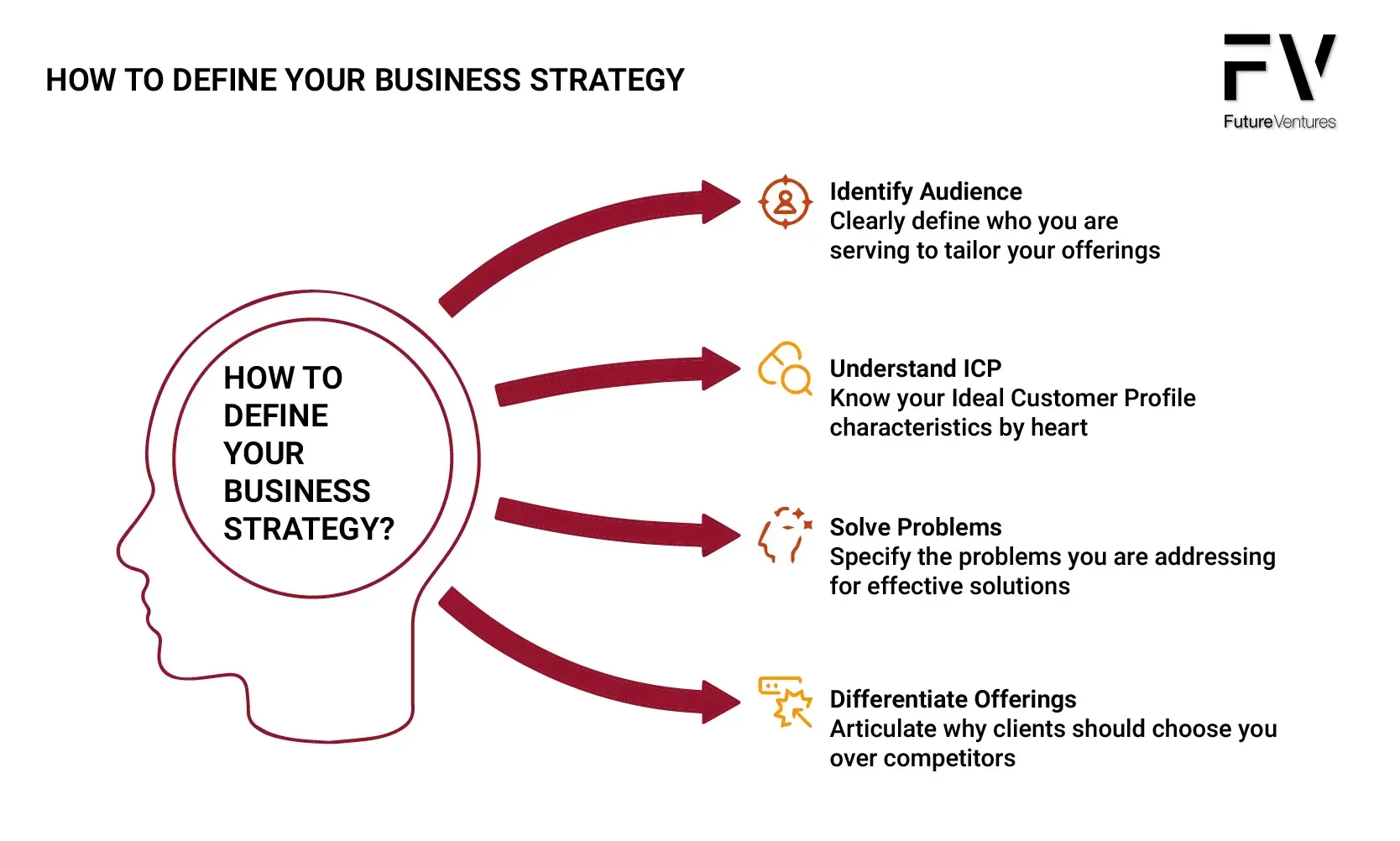Smart Business Development for Professional Services: The Ruthless Guide to Growth in the Digital Age
Before diving into the guide, here's what you need to know: Professional services firms that master Business Development (BD) outperform their competitors by 2-3x in growth and profitability a year. Stack this up over three years, and this exponential growth to the power of 3 is the difference between staying where you are and swinging for the fences.
This guide isn't about incremental improvements; it's about transformative strategies that separate the exceptional from the mediocre. By embracing technology, refining your approach, and applying the principles outlined here, you'll position yourself to capture more market share and build lasting client relationships in an increasingly competitive landscape.
What the Hell is Business Development, Really?
Business development isn’t schmoozing at networking events or sending generic “just checking in” emails that clog inboxes like digital cholesterol.
Business development is the strategic process of identifying and creating opportunities to grow value: both for your firm and your clients. It’s the oxygen that keeps professional services firms alive, especially in an era where client loyalty is about as permanent as a Snapchat message.
Think of business development as the Operating System (OS) of your firm’s growth machine. It’s not just about landing new clients (though that’s crucial); it’s about orchestrating a symphony of relationship-building, need-identification, value communication, and account expansion that creates sustainable revenue streams. Business development professionals play a vital role in this process by focusing on client acquisition, relationship building, and supporting business strategies to ensure the firm's financial success.
Why does BD matter?
Because 80% of professional services firms die not from incompetence but from starvation. They simply can’t generate enough new business to sustain operations. The firms that thrive are those that turn business development from a random act of desperation into a systematic, technology-enabled process.
In the professional services arena, business development goes beyond market knowledge to include understanding the psychology, status, and career risks of decision-makers responsible for approving significant engagements. It's crucial to convey your value effectively to those controlling the budgets.
Recognize the decision-making hierarchy, involving both technical experts and budget holders, and understand their decision-making process and the career risks they face when choosing your services.
Often, decisions hinge not on the highest value proposition but on perceived risk. Big-name firms are often seen as safer choices, even if they offer less value compared to specialized consultancies.
The Importance of Driving Brand Awareness and Brand Reach
Many professionals often undervalue their offerings, which can lead to underpricing and missed growth opportunities. This is where the significance of driving brand awareness and expanding brand reach becomes crucial.
Brand awareness is about ensuring that your target market recognizes and remembers you and your firm, setting you apart in a crowded marketplace. By effectively promoting your brand, you create a strong presence that resonates with potential clients and differentiates you from competitors. This is essential for professional services firms aiming to establish a foothold in an industry.
Expanding brand reach involves strategically extending your influence to new markets and audiences. This can be achieved through various business development strategies, such as participating in industry conferences, leveraging social media platforms, and engaging in thought leadership activities, especially the ones that are co-branded with another provider. By doing so, you not only attract new clients but also reinforce your firm's reputation as a leader in your field.
Benefits of Business Development
Business development is the lifeblood of any professional services firm, driving growth, profitability, and long-term success. Here’s why effective business development is indispensable:
- Increased Revenue: Strategic business development efforts can lead to acquiring new clients, expanding services, and creating additional revenue streams. This is the fuel that powers your firm’s growth engine.
- Improved Competitiveness: A well-crafted business development strategy helps your firm stand out in a crowded market. By differentiating your services and establishing a strong market presence, you can outmaneuver competitors.
- Enhanced Reputation: Consistent and effective business development boosts your firm’s visibility and credibility. A strong reputation attracts more clients and opens doors to new opportunities.
- Better Client Relationships: Business development isn’t just about landing new clients; it’s about nurturing existing ones. Stronger, more meaningful client relationships lead to increased loyalty and higher retention rates.
- Increased Efficiency: A strategic approach to business development streamlines operations, reduces costs, and improves overall efficiency. This allows your firm to do more with less, maximizing resources and impact.
In essence, business development is not just a function—it’s a strategic imperative that drives sustainable growth and competitive advantage.
The Strategy Behind Exceptional Growth
Most professional services firms approach business development strategy like teenagers approach dating: with hope, anxiety, and a fundamental lack of clarity about what they actually want. This doesn’t work in romance, and it absolutely tanks in business.
A proper business development strategy isn’t just some aspirational PowerPoint gathering digital dust on your shared drive. It’s a battle plan for capturing market territory. Strategy without specificity is just wishful thinking wrapped in consultant-speak. Developing business development skills is crucial for executing a successful strategy, as these skills can be cultivated over time to drive growth and client engagement.
Here’s the framework that separates leaders from losers:
- Market Penetration: Selling more services to existing clients. It is known as "land and expand". The lowest-hanging fruit that many firms ignore while chasing shiny new prospects.
- New Market Development: Taking your existing services to new sectors or geographical areas. Finding the adjacencies.
- Service Development: Creating new offerings for your current client base. I am a massive fan of customer discovery. One, it helps you to understand your client better and how to drive value for them. Second, if you hear the same problem repeatedly, it provides you with a pattern to explore.
- Diversification: The highest-risk, highest-reward approach drives new services to new markets.
- Specialization: Becoming the undisputed expert in a specific domain. The fastest-growing firms are 3X more likely to be highly specialized. Niches make riches. The more specialized you are, the higher RPH you can command.
We recently worked with a boutique shop. For years, they offered generic “business improvement” services across various industries: growing at a modest 5% annually and struggling under pressure from both technological advancements and competition. After specializing in digital transformation for healthcare providers and integrating AI-powered client insights into their approach, they tripled their growth rate within 18 months while increasing their average project value by 40%.
Your strategy must answer these questions with brutal honesty:
- Who exactly are you serving?
- Can you recite all the characteristics of your ICP without hesitation and without taking a breath?
- What specific problems are you solving?
- Why should clients choose you over the numerous alternatives?

Making Business Development Actually Work
Here's the uncomfortable truth: Most business development initiatives fail not because the strategy is flawed but because execution is inconsistent. Success isn't about grand gestures; it's about daily disciplines. Professionals who actively build pipelines ensure a predictable flow of revenue from existing clients, creating a stable foundation for growth.
Consider this analogy: Business development is less like hunting (the occasional big kill) and more like farming (consistent planting, nurturing, and harvesting). The professionals who excel treat it as an integral part of their daily routine rather than a separate activity they tackle when billable work slows down. Or, worse, in between projects.
The keys to effectiveness:
- Daily Microdoses: Spend 15-30 minutes each day on business development activities. This focus on BD compounds dramatically over time, like investing small amounts consistently.
- Audience Curation and Segmentation: You don't need to be a "baller", using a CDP, to excel in this area. There are numerous free and paid tools available that can help you enhance your audience data. By personalizing the journey and outreach, you increase the chances that your message will be opened and engaged with.
- Overinvest in MarTech: The cheapest and easiest investment you can make is to load up your website with tags that help you analyze who is visiting your website, what they are engaging with, and what the intent was: branded, commercial, informational, etc.
- Tech-enabled targeting: Use AI-driven tools to identify which potential clients are showing buying signals rather than wasting time on cold prospects. Platforms like Introhive can map the strength of relationships across your firm, identifying warm introduction pathways you may never have known existed.
- Ruthless qualification: Not all opportunities are created equal. The BANT framework (Budget, Authority, Need, Timeline) still works, but AI-enhanced qualification systems can now predict conversion probability with remarkable accuracy.
- CRM discipline: Your memory is unreliable; your CRM isn't. Document every meaningful interaction. Modern systems, such as Salesforce or HubSpot, don't just store information—they surface insights and trigger automated follow-ups.
- Focus on momentum: In business development, velocity matters. A mediocre proposal delivered quickly often outperforms a perfect proposal delivered late. Use project management tools to maintain momentum on high-potential opportunities.
- Networking, the Super Power: When executed with purpose and strategy, networking remains a powerful tool for generating new business opportunities. It enables you to establish meaningful relationships with prospective clients and industry peers, identify opportunities, and explore adjacent markets.
Where do most professionals fail?
They treat business development like crash dieting rather than lifestyle change. They go all-in for two weeks when work is slow, then disappear into client projects for months. This start-stop approach guarantees mediocre results. Business development activities often become unplanned and inconsistent due to time constraints, further exacerbating this issue.
The Business Development Skills That Separate Winners from Losers
The exceptional business developer in 2025 isn’t just a smooth talker with a firm handshake, bravado and loads of levity—they’re a technologically-savvy relationship architect who blends emotional intelligence with data fluency. Crucially, they possess advanced business development skills that are essential for success in modern business development, including sales and client relationships.
The four pillars of modern business development expertise are:
- Storytelling mastery: The greatest skill you can develop is storytelling. Period. It’s not just about being entertaining; it’s about framing complex value propositions in compelling narratives that stick in clients’ minds. Scott Galloway doesn’t just present data; he creates narrative frameworks that make information memorable and actionable.
- Digital relationship building: The ability to create authentic connections through digital channels is no longer optional. From LinkedIn thought leadership to personalized video messages, professionals who can build rapport without in-person interaction have an insurmountable advantage.
- Data interpretation: The modern business developer doesn’t just use data—they translate it into insights that drive decisions. This means understanding analytics, pattern recognition, and visualization techniques that turn information into persuasion.
- Systems thinking: Seeing how various business functions interconnect allows you to identify opportunities others miss. The most effective business developers connect dots between seemingly unrelated challenges to create holistic solutions. Strong project management is the most important skill for business development teams in high-growth firms as it ensures the seamless execution of these interconnected strategies.
Consider how this plays out: The average professional sends a proposal and follows up with “Did you get a chance to review?”, "Bumping up this message in your inbox", "Are you in or are you out?"
The exceptional professional analyzes document engagement data (which pages were viewed and for how long), incorporates that intelligence into their follow-up strategy, and addresses specific concerns before they’re even raised.
The technology stack that powers these skills has evolved dramatically. AI-powered tools now analyze communication patterns to suggest optimal outreach timing, recommend language that resonates with specific personality types, and even predict objections before they arise.
High-Impact Business Development Activities
Not all business development activities deliver equal returns. The difference between professionals who struggle and those who thrive often comes down to where they invest their limited time and attention.
The activity hierarchy, from highest to lowest impact:
- Strategic account expansion: Growing existing client relationships is 5-7X more cost-effective than acquiring new clients. Use relationship intelligence tools to map stakeholder networks within client organizations and identify expansion opportunities.
- Thought leadership amplification: Creating valuable content is just the starting point. Strategic distribution and amplification through AI-driven content platforms can extend your reach exponentially. Professionals who systematically repurpose their insights across channels (turning a webinar into blog posts, social media content, and email campaigns) generate 3X the engagement.
- Selective networking: Quality trumps quantity. Rather than attending every industry event, use tools like Meetup analytics and LinkedIn Sales Navigator to identify gatherings where decision-makers concentrate. One meaningful connection with a potential client trumps fifty business card exchanges with non-buyers.
- Digital nurturing sequences: Automated but personalized communication flows keep you top-of-mind with prospects. Modern platforms can trigger specific content based on prospect behavior (website visits, content downloads) rather than generic drip campaigns.
- Strategic alliances: Identify complementary service providers and create formal referral systems with tracking mechanisms. Technology now enables seamless client handoffs and shared visibility into opportunity progression.
The case of Elena, a management consultant, illustrates this hierarchy in action. After analyzing her time allocation, she discovered she was spending 70% of her business development time on low-impact activities like general networking events. After redistributing her efforts toward strategic account expansion and thought leadership, she doubled her new business pipeline within one quarter while reducing the time spent on business development by 30%.
Tip: In our firm, we have an MSW framework:
- M stands for Must Go. Your client is putting on an important event, and you must be there.
- S for Should Go. Those events sound like good networking opportunities.
- W for Wanna Go. Those are the events that you want to go to.
If it "ain't" a M or a W, we "ain't" going. So, forego all of those Should Go.
Building Client Relationships That Actually Last
Client relationships in professional services have undergone a fundamental shift. The days when golf outings and holiday gifts could maintain loyalty are as dead as the landline phone. Today's relationships are built on the continuous delivery of value, digital engagement, and a deep understanding of client objectives.
The Relationship Development Matrix
Evolving from Transactional to Strategic Partnerships
| Shift | From | ➡️ | To | How to Enable It |
|---|---|---|---|---|
| Transactional ➡️ Strategic | Project-based execution | ➡️ | Strategic partnership | ✅ Implement systems (e.g., Affinity) to capture client goals, challenges, and priorities. Use data to uncover unstated client needs and priorities. |
| Reactive ➡️ Proactive | Problem-response mode | ➡️ | Anticipatory guidance | 🔍 Use predictive analytics to identify upcoming needs via industry trends, business cycles, and historical behavior. Be the first to offer value. |
| Episodic ➡️ Continuous | Infrequent engagement | ➡️ | Regular value delivery | 📈 Create ongoing touchpoints (e.g., customized market insights, benchmark data, regulatory alerts) using automated + curated systems for relevance. |
| Individual ➡️ Institutional | Key person dependency | ➡️ | Firm-wide relationship | 🕸️ Use CRM tools to map all client interactions across your organization, ensuring relationship continuity beyond any one team member. Client relationship platforms can map every touchpoint between your organization and the client's, ensuring no relationship exists in a silo vulnerable to personnel changes. |

When 86% of buyers say they're more likely to purchase when their goals are understood, the imperative is clear: relationship depth trumps relationship breadth. One client who views you as indispensable is worth more than ten who see you as interchangeable.
Content Marketing: Beyond the Bullshit Blog Posts
Content marketing for professional services has reached a critical inflection point. The market is saturated with mediocre thought leadership that's neither thoughtful nor leading. Standing out requires a fundamentally different approach.
The content hierarchy of needs:
- Contrarian insight: Take a defensible position that challenges conventional wisdom. Scott Galloway didn't build his audience by regurgitating what everyone already believed; he gained attention by making bold, data-supported claims that challenged assumptions.
- Practical application: Move beyond theoretical frameworks to concrete, implementable guidance. Content that helps clients take immediate action creates a disproportionate impact.
- Visual distinction: In a sea of white papers and text-heavy posts, visual storytelling cuts through. Invest in distinctive data visualization, custom graphics and video content that communicate complex ideas in a simple and easy-to-follow manner.
- Algorithmic optimization: Use AI-powered tools to identify trending topics in your sector before they peak, ensuring your content rides the wave of interest rather than following it.
- Strategic distribution: Content without distribution is like a beautiful store in an abandoned mall. Use platforms like GaggleAMP or Clearview Social to activate your entire organization as distribution channels.
Consider the transformation at Deloitte Digital, a company I used to work for many years ago. After analyzing content performance, they discovered their most technical, jargon-filled pieces actually performed worst with target C-suite audiences. After shifting to more provocative, plainly-written content with strong visual elements, they saw engagement increase by 320% and directly attributed $15M in new business to their revised content approach.
The Science of Modern Business Development Process
Business development isn't an art. It's a science with predictable inputs and outputs. The most successful professionals treat it as a process to be optimized rather than a talent to be cultivated.
The modern business development engine has five key components:
- AI-powered opportunity identification: Use machine learning algorithms to analyze market signals and identify potential clients before they even know they need your services. Technologies like Crayon and Kompyte track competitor vulnerabilities, leadership changes, and market shifts that indicate buying opportunities.
- Automated outreach optimization: A/B test different outreach methods, messaging, and timing using platforms that can determine which approaches generate the highest response rates for different prospect segments.
- Digital relationship tracking: Implement relationship intelligence systems that score interaction quality, not just quantity. These platforms analyze communication patterns, response times, and engagement levels to predict the strength of relationships and the viability of opportunities.
- Proposal automation and tracking: Utilize technologies like Qwilr or PandaDoc that not only streamline proposal creation but also provide real-time analytics on how prospects engage with your proposals: specifically, which sections they focus on and which they skip.
- Continuous improvement cycles: Implement systems that analyze win/loss data to identify patterns in successful business development efforts, creating a feedback loop that continuously refines your approach.
The professional services firms that grow fastest have transformed their business development from a black box of relationship magic to a transparent, technology-enabled process with clear inputs and measurable outputs.
Strategies That Actually Move the Needle
Let's be brutally honest: most common business development strategies deliver mediocre results because they're implemented in half measures. The strategies that actually drive growth require full commitment and technological enablement.
Four strategies that deliver outsized returns:
- Hyper-specialization: The narrower your focus, the broader your opportunities. Firms that specialize in solving specific problems for specific industries grow 3X faster than generalists. Use market intelligence platforms to identify underserved niches where your expertise can command premium rates.
- Digital Authority Building: Systematically build recognized expertise through a coordinated digital presence. This isn't just random posting—it's a structured program of content creation, speaking engagements, and media appearances, all amplified through technology platforms that extend reach.
- Account-Based Marketing (ABM): Instead of casting a wide net, identify high-value target accounts and orchestrate personalized campaigns across multiple channels. Modern ABM platforms can coordinate outreach across email, social, advertising, and direct mail for a seamless, consistent experience.
- Strategic Acquisitions: Sometimes, buying growth is smarter than building it. Use data analytics to identify smaller firms with complementary capabilities and strong client relationships that could accelerate your market penetration.
The legendary management consulting firm McKinsey demonstrates these principles in action. Their specialization strategy includes establishing focused institutes around emerging topics, such as AI and sustainability. Each institute becomes a content engine, a relationship accelerator, and a market positioning tool. All supported by sophisticated technology platforms that amplify their influence far beyond what traditional approaches could achieve.
Measuring What Actually Matters
If you can't measure it, you can't improve it. Yet most professional services firms track vanity metrics that have little correlation with actual business development success. Data analytics is a critical skill that allows firms to monitor key metrics and make informed decisions about marketing techniques, ensuring that their efforts are both effective and efficient.
The metrics hierarchy, from most to least valuable:
- Client Lifetime Value (CLV): The total revenue a client generates over their relationship with your firm. This focuses attention on long-term relationship building rather than transactional wins.
- Opportunity Velocity: How quickly potential deals move through your pipeline. Stalled opportunities cost attention and resources without delivering returns.
- Relationship Depth Score: A composite metric measuring the breadth and depth of connections with key client organizations. More touchpoints across different departments and levels reduce vulnerability to personnel changes.
- Content Engagement-to-Revenue Ratio: Not just how many people consumed your content, but what percentage ultimately converted to revenue-generating relationships.
- Referral Rate: The percentage of new business coming from existing client referrals is a key indicator of client satisfaction and relationship strength.
Technology now allows for the sophisticated tracking of these metrics through integrated CRM, marketing automation, and business intelligence platforms. The firms that grow fastest have dashboards that visualize these metrics in real-time, allowing for agile adjustments to business development activities.
Roles, Responsibilities, and the Reality of Making This Work
The traditional model of business development in professional services, where rainmakers were expected to both execute client work and generate new business, is dead. The complexity of modern business development demands specialized roles and clear accountability. Many professionals feel an aversion to selling, which complicates their business development efforts. A marketing team is crucial for managing tasks such as proposal writing and client communication, and they collaborate closely with the business development team to create cohesive strategies. Marketing creates the platform and awareness to assist business development activities and generate leads.
The optimal business development team structure includes:
- Market Intelligence Specialists: Dedicated to identifying market trends, competitive movements, and potential opportunities using AI-powered listening tools and data analytics.
- Content Strategists: Responsible for orchestrating thought leadership that positions your firm at the forefront of industry conversations.
- Digital Engagement Managers: Experts in leveraging social and digital platforms to build and nurture relationships at scale.
- Client Success Architects: Focused specifically on expanding relationships with existing clients through a deep understanding of their evolving needs.
- Business Development Operations: The often-overlooked function that maintains technologies, processes, and metrics that enable everyone else to succeed.
Marketing promotes the firm's existing services and key individuals to its target audience, ensuring that the right message reaches the right people.
- Market Intelligence Specialists: Dedicated to identifying market trends, competitive movements, and potential opportunities using AI-powered listening tools and data analytics.
- Content Strategists: Responsible for orchestrating thought leadership that positions your firm at the forefront of industry conversations.
- Digital Engagement Managers: Experts in leveraging social and digital platforms to build and nurture relationships at scale.
- Client Success Architects: Focused specifically on expanding relationships with existing clients through a deep understanding of their evolving needs.
- Business Development Operations: The often-overlooked function that maintains technologies, processes, and metrics that enable everyone else to succeed.
Even smaller firms need to allocate these responsibilities clearly, whether through dedicated personnel or the fractional allocation of existing team members’ time. The key is accountability. Someone must own each function, or it simply won’t happen consistently.
Client Experience as Business Development Rocket Fuel
Client experience isn't just a feel-good initiative; it's your most powerful business development tool. In an age where differentiation on expertise alone is nearly impossible, how clients feel about working with you often determines whether they buy again and refer others.
The client experience revolution involves:
- Journey Mapping and Optimization: Use specialized software to map every touchpoint in the client journey, identifying friction points and opportunities for delight. Platforms like Qualtrics and Medallia can capture real-time feedback at critical junctures.
- Expectation Management Systems: Implement technologies that clearly document client expectations and track delivery against those expectations, with automated alerts when misalignment occurs.
- Value Demonstration Protocols: Establish systematic approaches to measuring and communicating the impact of your work. The firms that grow fastest don't just deliver value; they ensure clients recognize that value through regular, data-supported reviews.
- Client Success Programs: Move beyond reactive account management to proactive client success initiatives that anticipate needs and deliver solutions before problems emerge.
When implemented correctly, exceptional client experience becomes a self-perpetuating business development engine. Clients who experience the stark difference between your approach and competitors' become advocates who drive referrals and provide testimonials that accelerate sales cycles with new prospects.
Best Practices That Aren't Just Consultant-Speak
Let's conclude with actionable best practices that separate the exceptional from the average in professional services business development:
- Embrace technological augmentation: Professionals who leverage AI, automation, and data analytics to extend their capabilities will outperform those who rely on traditional approaches alone. Start with one technology solution focused on your biggest business development challenge rather than attempting wholesale transformation.
- Build systems, not dependencies: Document and systematize your business development activities so they don't rely on any individual's relationships or heroic efforts. The most valuable firms have business development systems that transcend any single person.
- Prioritize ruthlessly: Focus 80% of your business development efforts on the 20% of activities and opportunities that deliver the highest returns. Use data to identify these high-leverage points rather than relying on intuition.
- Integrate, don't separate: Embed business development into every client interaction rather than treating it as a separate function. Every deliverable should set the stage for the next opportunity.
- Measure relentlessly: Establish clear metrics for business development success and review them regularly, making data-driven adjustments to your approach based on what's working and what isn't.
The firms that implement these practices consistently, supported by appropriate technology and clear accountability, don't just survive; they thrive in even the most challenging market conditions.
The ultimate truth about business development in professional services is this: It's not about being better than your competition; it's about being different in ways that matter to clients. Business development is more of an outbound activity aimed at generating new business, while marketing is more of an inbound activity. When you combine strategic clarity, technological enablement, and consistent execution, you create a business development engine that drives sustainable growth regardless of market conditions. Professionals often combine marketing and business development roles, which can confuse their distinct responsibilities, making it essential to define and separate these functions clearly. Effective business development and marketing strategies require a clear distinction between their functions to optimize resource allocation.
Conclusion
Business development in professional services has transformed from an art practiced by a select few rainmakers into a scientific discipline enabled by technology and driven by data. The firms that recognize and embrace this shift will capture disproportionate market share while others wonder why their traditional approaches yield diminishing returns.
The future belongs to those who combine the timeless principles of relationship building and value delivery with the modern advantages of technology, specialization, and systematic process. By implementing the strategies outlined in this guide, you position your firm not just to compete but to dominate in the evolving professional services landscape.
Opportunity is enormous. Technology is available. Differentiation is waiting to be claimed. The only question is whether you'll be the one to seize it or whether you'll watch from the sidelines as more agile, forward-thinking competitors leave you behind.










